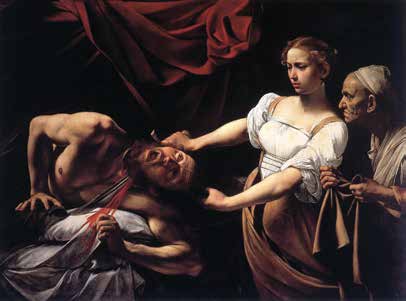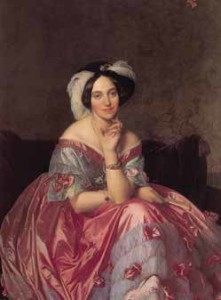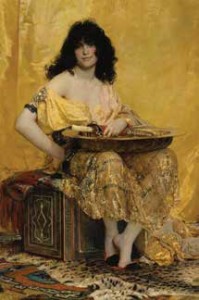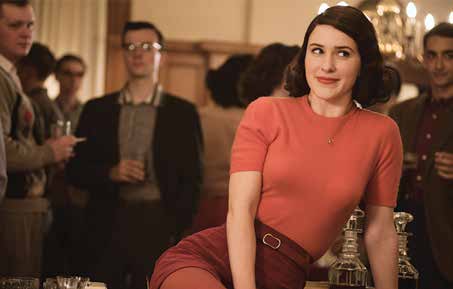Tag : Amazon
April 17, 2018 by admin
La Belle Juive
“There is in the phrase ‘a beautiful Jewess’ a very special sexual signification, one quite different from that contained in the words ‘beautiful Rumanian’, ‘beautiful Greek’, or ‘beautiful American’, for example. This phrase carries an aura of rape and massacre. The ‘beautiful Jewess’ is she whom the Cossacks under the czar dragged by her hair through the streets of the burning village.”
Jean-Paul Sartre, Jew and Anti-Semite (1965)
As a keen museumgoer, I have spent countless hours looking at paintings of beautiful Jewish women. In my own imagination’s gallery, there is a special place for Caravaggio’s Judith Beheading Holofernes, Veronese’s Rebecca at the Well, Delacroix’s Jewish Wedding in Morocco, Henri Regnault’s Salomé, and Ingres’s Baronne de Rothschild. The list could be much longer, with portraits of Ruth, Esther, Sarah, and a dozen more. Yet until recently I had not realized that the motif of the beautiful Jewess—the belle Juive as it is called in French, where it appears most frequently—is a recurrent and evolving trope in Western literature and the visual arts.

Caravaggio’s Judith Beheading Holofernes
My curiosity was rekindled recently when I read the novel Compass by Mathias Enard, which won the 2015 Prix Goncourt in France. Narrated by an erudite and sickly musicologist, Franz Ritter, this book is an exquisite ode to the Orient. Not Orient as in Asia, but rather the exoticism that intellectual historian Edward Saïd in 1978 labeled “Orientalism.” He traced its origins to the long period of colonization that start-ed with the Napoleonic invasion of Egypt in 1798 and ended roughly in the middle of the 20th century. Europe dominated North Africa and the Middle East, and from its position of power defined “the Orient” as a reverse image to the West.
In Compass, the narrator, a connoisseur of Islamic culture who is tracing the influence of Oriental music and literature in the West, becomes spellbound by a French Jewish woman of Sephardic descent who herself is a specialist in these cultures. Sarah is an elusive, exotic figure, with brains, too; she is able to navigate Eastern and Western cultures with equal ease—a shrewd mediator between worlds. Was she a belle Juive, the idealized object of a certain type of fantasy? And was a belle Juive a mere object of desire, or could she be a subject, too? As a Moroccan-born Jewish woman living in the Western world for decades myself, I thought the image of this exoticized creature was worth exploring. It could even be a way of probing my own identity as a go-between, both Eastern and Western, neither exclusively one nor the other. The search became personal. So I started to dig.
Created by non-Jewish men, the belle Juive is an expression of the most sincere philo-Semitism, and a violent anti-Semitism too. But it also resonates with male fears of the feminine, with an additional dose of further exoticizing women from a group—Jews—already viewed as exotic and “other.”
Is the belle Juive a gauge of the fantasies, anxieties and neurosis of the societies we live in? And what are the social uses of this fictitious image? How can we tell the belle Juive apart from the actual lives of Jewish women? And what do Jewish women themselves have to say on the subject?

Ingres’s Baronne de Rothschild
Hagar, Sarah, Rebecca, Ruth, Esther, Judith, Salomé: the Christian world’s portrayal of this long procession of beautiful biblical women continues from medieval Christian mystery plays through the effervescence of the Enlightenment. But the Jewishness of these figures has often been obscured or erased. Viewed compassionately, they stand in stark contrast to the Jewish men who were singled out as direct objects of anti-Judaism. Pitiable Jewish women also appeared in scenes of the Passion, weeping for Christ, or in portrayals of the Massacre of the Innocents, begging King Herod’s soldiers to spare the lives of Jewish children. This Jewess is a figure akin to the Virgin Mary, close to the Church. She betrays the ambiguity of Christianity towards Jews, who are viewed both as precursors of the Christian religion and as the murderers of Jesus.
I realized that in the 17th century, French classical theater further transformed these Jewesses into exemplars of piety, virtue, and morality, their beauty more classical than “Oriental.” For instance, Racine’s Esther (1689), drained of all her sensuality, is more a Christian than a Jewish character, a legitimate spouse rather than the first wife in the King’s harem.
At the end of the 18th century, France became the first Western country to offer Jews the rights of full citizens, so Jews became more visible in French society. The leitmotif of the belle Juive doesn’t solidify in France until the first part of the 19th century, perhaps its emergence tied to the newly granted emancipation of Jews.
Simultaneously, the vogue for Orientalism came with the colonial enterprise in Europe throughout the 19th century. The belle Juive thus is marked by both Jewish emancipation and Orientalist fantasies.
And then there was 19th-century Romanticism, which constructed a wall between the Jew—always defined as male—and the Jewess, prompting Chateaubriand to declare, in 1825, in his Essays on English Literature: “Jewesses have escaped from the curse of their race. None of them were to be found in the crowd that insulted the Son of Man…. The reflection of some beautiful ray will have rested on the forehead of the Jewesses.” And at the end of the 19th century, the writer Paul Bourget quipped: “I hate Jews because they crucified Christ. I adore Jewesses because they wept for him.” The Jewish woman’s appeal doesn’t, however, reside in her intrinsic qualities. Rather she fascinates because she is more susceptible to conversion and assimilation.

Henri Regnault’s Salomé
Between 1820 and 1830, the image of the belle Juive takes root in Walter Scott’s Ivanhoe (1820), and she gets even more complex. The frequent use of the term “belle Juive,” used for the first time in this English novel, is the label for Rebecca, daughter of Isaac of York. The Jew and his daughter reflect a distinctive philo-Semitic turn. Rebecca is endowed with multiple moral qualities matched by her physical graces. But there’s a change. The restrained beauty of Helen of Troy or Diana that characterized earlier Jewesses is replaced for the first time by a carnal seductiveness, described in great detail. She is an “Oriental houri,” a “beautiful flower of Palestine,” the “bride of Song of Songs,” “a beautiful Jewish magician.” This new iteration of the belle Juive spread like wildfire to France later that year, when the novel was translated into French. In Germany, too, the proliferation of salons, in which wealthy Jewish families mingled with nobility, turns out to have paved the way for the stereotype. The Berlin Jewish salonnières in particular—among them Dorothea Schlegel Mendelsohn and Rahel Levin Varnhagen—were highly prized not only for their wealth and cultivation, but also for their beauty. They satisfied a romantic enthusiasm for the exotic and the sensual, and this infatuation often led to their being seen by Christian men as desirable marriage partners.
Portrayals of beautiful Jewesses in art and literature especially began to multiply after the French invasion of Algiers in 1830. Confronted with local Jewish women, the archetype became richer and more specific. La belle Juive now was primarily associated with the “Oriental” woman. Anchoring one of the great fantasies of the 19th century, the Orientalist cliché crystallized.
This exoticized female “other” is depicted as submissive, passive and lascivious. Amidst the long list of such beauties—Turks, Egyptians, Greeks, Moors, Armenians, Abyssinians, and Copts—the Jewess is the most unsettling of all, the high-est expression of exoticism. Doubly prized, for being both Oriental and biblical, she embodies the Other. She is ardently sought by 19th-century Western travelers, consumed with a desire “to see” what is hidden “behind the veil” as much as what lies “behind the ghetto,” Eastern or Western. Her particular beauty, ancient and primeval, is often described as perfect. Such descriptions can sound a dissonant note too. Balzac penned a passage referring to his work’s belle Juive as being “white as snow” with “eyes like velvet, black lashes like rats’ tails…” This Jewess is both familiar and foreign, even threatening.
If the belle Juive helped Western men imagine the Oriental Other, it also unlocked the dangers of a different Other too, one closer to home: women. La belle Juive was another way of revisiting acceptable representations of the feminine. Portrayals of womanhood in the 19th century typically oscillated between the image of the Madonna and that of a corrupting seductress. As the gentler first half of the 19th century hardened into more overt anti-Semitism, la belle Juive became conflated with the image of the femme fatale. Literary critic Sander Gilman focuses on this as the Escher-like image of the Jewish woman. Is she primarily a woman, or primarily a Jew? The Jewess was seen as threatening because she was Jewish, but also because she was a woman, with voracious desires and uncommon ambitions.
I found this nowhere better illustrated than in the mythologizing surrounding the Jewish actress Sarah Bernhardt (1844-1923). La Divine Sarah reinvented herself as a carefully constructed public icon, allowing her stage roles to reflect her own life. Acting as Salomé, she cast herself as sexual seductress, as dangerous as she is tempting. In the role of the tubercular Marguerite Gautier in La Dame aux Camélias, she also conjured up anti-Semitic images of diseased (male) Jews whose yellow skin tones are marks of degeneracy, the signs of a corrupting modernizer. As she played up the image of her aggressive and transgressive sexuality, she was viewed as “mannish.” Fin-de-siècle anxiety about “modern woman” thus became intertwined with a corresponding image of the lesbian as a crypto-male. Matching the emancipated Jewish actress to the destructive biblical Jewess, Bernhardt steered the stereo-type of the belle Juive in a new direction: the modern Jewess.

Sarah Bernhardt
By 1900, la belle Juive was no longer a passive, submissive figure. Earlier on, she had embodied both East and West, exclusively neither one nor the other. She had always been an exotic creature haunting the boundaries. Now, as other sorts of marginalities emerged—along with the new paths of women’s emancipation—la belle Juive probed more spaces in the periphery.
Other changes occurred too: beauty standards were drastically upended after World War I, with the emergence of a more androgynous look. So la belle Juive became less about the physical beauty of the Jewess, and more about her ideals. The 20th-century Jewess emanates from real figures, modern-izers and true revolutionaries like Emma Goldman and Rosa Luxembourg, aiming with messianic fervor to transform the whole world. La belle Juive has become a free agent, a fighter and a liberator, a harbinger of the future woman. She decidedly threatened the Fascist ideologies in the making.
In the wake of World War II and the Holocaust, and with the increased affluence of American Jews and their integration into political, economic, and cultural elites, the steady diminution of anti-Semitism might have led one to predict the demise of la belle Juive. Instead, she has transmuted once again, though this time almost entirely as a product of anxieties within the Jewish community itself. Cultural anthropologist Riv-Ellen Prell suggests that Jewish men in the postwar years were caught between two competing pressures: on one hand, to achieve success and admittance in the larger culture, on the other, to resist assimilation into that culture by remaining loyal to their origins. Such conflicts led Jewish men, Prell hypothesizes, to invent the cliché of the Jewish American Princess whose body is at once “exceptionally passive and highly adorned.” Lacking in sexual desire, she abundantly lavishes self-beautification. The JAP doesn’t sweat, doesn’t work, doesn’t tend to the needs of anyone else. Though her body is a surface to decorate, she is, unlike the older belle Juive, “desexualized and de-eroticized.” Her portrayal as self-absorbed is purported to explain why Jewish men feel powerless and dominated, unable to see Jewish women as objects of sexual desire.
American pop culture has mirrored the morphing image of the belle Juive in different guises, alerting us to its still insidious prevalence in our culture. In the 1990s, the television show The Nanny toyed with the image of a Jewish woman—Fran Fine—who plays the nanny to a WASP family: not quite a JAP though she may aspire to be one, she is loud and garish, more of a gaudy “Orientalist” caricature.

The Marvelous Mrs. Maisel
The 2017 Amazon show The Marvelous Mrs. Maisel provides new directions, spurred by new anxieties in the age of Trump. Set in the 1950s, it is the story of Miriam (Midge) Maisel. Initially, we see her life as picture-perfect: she is married to a Jewish man, has two lovely children in a palatial Upper West Side apartment, in the same building where her parents live. She doesn’t work, doesn’t sweat, and gets out of bed before her husband awakens to put on make-up and slip back between her well-pressed sheets to pretend, when her husband arises, that she has just opened her eyes. Her glossy lifestyle takes a hit, however, when her spouse cheats on her. But Midge is quick-witted and whip-smart (she was a Russian major at Bryn Mawr), and finds an outlet for her bile as a stand-up comedian in a downtown comedy club. Her style is brash: some cringe, others laugh. She ruffles a few feathers, digs deep into her wounds to expose truths no one ever talks about, tramples conventions and crosses boundaries, even getting arrested for it a few times. She is a recovering-JAP-turned-Sarah Bernhardt, a heroine for our times, a feminist provocateur when feminism is once again on guard.

Gal Gadot in Wonder Woman
And then there is Wonder Woman—the 2017 DC Films’ movie starring Israeli actress Gal Gadot. A superhero, an Amazon, she’s more righteous than the acid-tongued Mrs. Maisel. But her credentials as a belle Juive are unmistakable: she is the modern legatee to Rebecca of York. With words, fists, super powers, and above all, a mysterious self-confidence, Wonder Woman causes men around her to say phrases like “I am both frightened…and aroused.” We are back in the encounter of perplexed 19th-century Orientalists with belles Juives. Though her role is not explicitly Jewish, Gal Gadot has skillfully meshed her screen persona with real life. Her conspicuous Israeli accent roots her in her Jewishness—a fact that led Arab nations like Lebanon to ban the movie.
It turns out that the image of la belle Juive has embodied and represented profound changes in society, including its darkest preoccupations, sometimes facilitating change, sometimes obstructing it. The image is a dangerous distortion of reality. It may be time for a Jewish woman to reject the label of belle Juive with its troubling implications, and simply call herself Jew.
Yaëlle Azagury is a journalist and a critic who writes, among other topics, about French and Sephardic cultures. Her work has appeared in Lilith previously.
- No Comments
April 12, 2018 by admin
Girls at Hasidic Summer Camp
Be on the lookout for Pearl Gluck’s Summer, a short film of sexual exploration set in a Hasidic sleepaway camp in the Catskills. Gluck, 45, went from growing up Hasidic in Borough Park, Brooklyn, to college at Brandeis, with a quirky feminist affection for her roots. At the film’s world premiere at the January 2018 New York Jewish Film Festival, she cheerfully admitted to autobiography in this film she wrote, directed and produced.
The 18-minute film captures the ferocious energy of a camp full of adolescent girls and the gentle secrecy of two friends’ illicit inquiry into a copy of Our Bodies, Ourselves. (Though with all the current complexities of “consent,” one girl’s pressuring another makes this reviewer a little uncomfortable.) The attractive young rebbetzin entrusted with the campers’ moral education stays on message: “You are always in the presence of God, but you are also always in the presence of matchmakers.… Above all, don’t mess up your chances for a good match.” Look for Summer, with score by The Klezmatics’ Lisa Gutkin, on the film festival circuit.
Gluck’s Hasidic filmic feminism goes back to Divan (2003/Netflix, Amazon, Fandor). It’s her own Hasidic tale, journeying through Hungary in search of the ancestral couch where revered rebbes slept. Not a one-note filmmaker, her latest film, The Turn Out, explores sex trafficking at America’s rural truck stops. More on Gluck’s films and contact information to arrange screenings, at palinkapictures.com.
- No Comments
April 12, 2018 by admin
Is Midge Maisel a Bad Mom?
The assumption, for much of human history, that women would busy themselves with one source of joy [like mother-hood] and not the other [like work] meant that it took some time for women like Midge to find their voices. That those of us who actively choose the demands of family life do so with the full understanding that we must balance the cultivation of our own voices with the cacophony of the voices we nurture at home does not make that balance any easier. To distance oneself from a “terrible mom” like Midge is to pretend that deriving joy from our children does not, at some point or another, come at the expense of our own professional and creative endeavors. To criticize Midge’s parenting just when she is finding her voice is to miss the point of the show entirely.
SARA FREDMAN weighs in on Amazon’s The Marvelous Mrs. Maisel on the Lilith Blog
- No Comments
 Please wait...
Please wait...